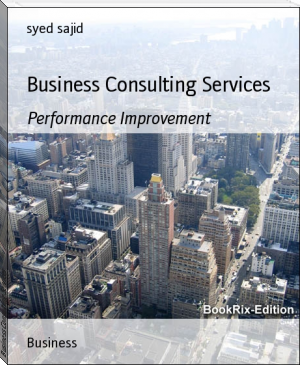Zimbabwe Business Manual 101 by Fidelis Fengu (book recommendations based on other books TXT) 📕

- Author: Fidelis Fengu
Book online «Zimbabwe Business Manual 101 by Fidelis Fengu (book recommendations based on other books TXT) 📕». Author Fidelis Fengu
There are two methods used to break down areas of a market:
Geographical areas - Specializing in serving the needs of customers in a particular geographical area. For example, a bird-watching guide would focus on areas where people would come who want to see birds.
Customer areas - Identifying those people most likely to buy the product or service and targeting those groups, such as divers or fishermen.
Managing the Market Mix
Every marketing program contains four key components:
Products and Services
Promotion
Distribution
Pricing
These key ingredients are combined into an overall marketing program.
Products and Services Product strategies may include:
Concentrating on a narrow product line, such as sport fishing
Developing a highly specialized product or service, such as fly-fishing, or
Providing a product or service package containing unusually high-quality service.
Promotion- Promotion strategies include advertising and direct customer interaction. Good salesmanship is essential for small businesses because of their limited ability to spend on advertising. Good telephone book advertising is also important. Direct mail is an effective, low-cost medium available to small business. There are also flyers and business cards you can make cheaply.
Price - The right price is very important for getting the most total revenue. Generally, higher prices mean fewer customers and vice-versa; however, small businesses can often command higher prices because of their personalized service.
Distribution- The manufacturer and wholesaler must decide how to distribute their products. Working through established sellers generally is easiest for small businesses. Small retailers should consider cost and traffic flow in site selection, especially since advertising and rent can be reciprocal:
A low-cost, low-traffic location means spending more on advertising to build traffic.
Market Mix
The nature of the product or service is also important in where deciding where to put your business. If purchases are based largely on impulse, then high traffic and visibility are critical. On the other hand, location is less a concern for products or services that customers are willing to go out of their way to find.
Marketing Performance
After implementing a marketing program, entrepreneurs must evaluate its performance. Every program should have performance standards to compare with actual results. Researching industry norms and past performance will help to develop appropriate standards. Entrepreneurs should audit their company's performance at least quarterly. The key questions are:
1. Is the company doing all it can to be customer-oriented? 2. Do employees ensure the customers are satisfied and leave wanting to come back and tell other people to come? 3. Is it easy for the customer to find what he or she wants at a competitive price?
What is Marketing?
In plain and simple terms, marketing activities and strategies result in making products available that satisfy customers while making profits for the companies that offer those products. That's it in a nutshell!
Marketing produces a "win-win" because:
Customers have a product that meets their needs, and
Healthy profits are achieved for the company. (These profits allow the company to continue to do business in order to meet the needs of future customers.)
Stated another way: A focus on what the customer wants is essential to successful marketing efforts. This customer-orientation must also be balanced with the company's objective of maintaining a profitable volume of sales in order for the company to continue to do business. Marketing is a creative, ever-changing orchestration of all the activities needed to accomplish both of these objectives.
How Are The Customer And Business Objectives Met?
The American Marketing Association's definition of marketing is: “the process of planning and executing the conception, pricing, promotion and distribution of ideas, goods, and services to create exchanges that satisfy individual and organizational objectives.” You can see in this definition that the process of marketing begins with discovering what product customers want to buy. Providing the features and quality customers want is a critical first step in marketing. You'll be facing an uphill battle if you provide something you want to produce and then try to convince someone to buy it. The marketing process then continues with setting a price letting potential customers know about your product, and making it available to them.
What Activities are Included in Marketing?
Sales
Packaging
Promotion
Information
Public Relations
Marketing Ideas
Local newspapers
Internet
Guidebooks
Word of Mouth
BTB Publications
Flyers and business cards
Radio
Brochures in hotels, restaurants, etc.
In Summary
These are the fundamentals of a true marketing mindset:
Producing what the customer wants should be the focus of business operations and planning.
Creating profitable sales volume, not just sales volume, is a necessary goal.
Coordinating between marketing activities and all other functions within a business that affect marketing efforts.
CUSTOMER SERVICE
Customer Service
The Golden Rule, "do unto others as you would have them do unto you," may seem self-evident in the way we try to conduct our personal lives. Yet this axiom is assuming new importance as a guiding principle in the world of business. The growing significance of meeting -- or exceeding -- customer demands for quality service has special implications for small business. For it is in this arena that small companies can, in the least expensive way, set themselves apart from the competition.
Golden Rule #1: Put the Customer First
Quality customer service begins with your employees. The first person that a customer will see is you and your employees. You all should be good ambassadors. If you take care of your employees then they are more likely to take care of your customers. Try offering service bonuses to increase employee morale and make them pay attention to customers.
Golden Rule #2: Stay Close To Your Customer
Asking questions and listening carefully to the answers is an important part of customer service. You lose money when you lose customers, so keeping them is what is going to make your business run.
You can see the evidence in these facts:
65% of a company’s business comes from existing customers
It costs 5 times as much to attract a new customer as it does to keep an existing customer happy
91% of customers will never use a company who has disappointed, failed, or offended them
The best business owners are not only committed to staying close to their clientele, but also identify with them. They give their customers the level of service they themselves would expect to receive.
Golden Rule #3: Pay Attention to the Little Details
Some of the most effective "extras" are really very basic adages of conducting good business, although customers are often surprised when they take place. These include:
Answering the phone by the third ring;
Treating customers respectfully and courteously at all times;
Greeting them by name;
Promptly answering their questions and, if you can't, getting back to them with an answer as quickly as possible;
Five Rules of Customer Care
Understanding customers and the way they think is critical to keeping them. For example, customers do business on the basis of emotional desire: they want what they want -- when they want it. Customers also tend to gravitate toward a company or group of people they like. Plus, most customers have a strong tendency to stick with businesses with which they are familiar, and are slow to change buying habits unless given a very good reason. However, when they are displeased, even by a small disappointment or discourteous word, various surveys have revealed that customers tell from seven to 11 people about their dissatisfaction. An important key to serving customers well is this: don't try to change them.
Steps to help you take full advantage of the critical element of customer care:
Rule 1: Research- Conduct your own survey. Profit from the ideas, suggestions and complaints of your present and former customers. Talk and meet with your customers. Ask questions. Learn their attitudes, what they want and what they dislike.
Rule 2: Manners- Check employees' telephone manners periodically. This link is particularly important for small businesses, as bad telephone handling can undermine other constructive efforts to build a profitable enterprise.
Rule 3: Positive Attitudes- Rules such as prompt answering and a cheerful attitude of helpfulness are of critical importance. Have someone whose voice is unfamiliar play the role of a customer or prospective customer, preferably a difficult one.
Rule 4: Team Work- Make customer service a team effort. Use group meetings, memos, posters and in-house publications to build customer consciousness throughout the organization. Continually drive home the crucial rule that getting and holding customers requires team play, and invite employee ideas.
Rule 5: Never Stop Working- Extend your efforts after hours. It's the friendly feelings people have that draw them to you and your business. Take advantage of the relaxed atmosphere of social occasions or a neighborly chat to turn friends into customers, or to reinforce the loyalty of existing ones.
Extra information: BUSINESS MANAGEMENT
Financial Statements
Understanding financial statements is critically important to the success of a small business. Financial statements can be used as a roadmap on your business journey to economic success. Using numbers can steer you in the right direction and help you avoid costly mistakes. Most business owners don't realize that financial statements have a value that goes far beyond their use to prepare tax returns or loan applications.
The Balance Sheet
The balance sheet is a snapshot of the company's financial standing at an instant in time. The balance sheet shows the company's financial position, what it owns (assets) and what it owes (liabilities and net worth). The "bottom line" of a balance sheet must always balance (i.e. assets = liabilities + net worth). The individual elements of a balance sheet change from day to day and reflect the activities of the company. Analyzing how the balance sheet changes over time will reveal important information about the company's business trends. In this section, we'll discover how you can monitor your ability to collect revenues, how well you manage your inventory, and even assess your ability to satisfy creditors and stockholders.
Liabilities and net worth on the balance sheet represent the company's sources of funds. Liabilities and net worth are composed of creditors and investors who have provided cash or its equivalent to the company in the past. As a source of funds, they enable the company to continue in business or expand operations. If creditors and investors are unhappy and distrustful, the company's chances of survival are limited.
Assets, on the other hand, represent the company's use of funds. The company uses cash or other funds provided by the creditor/investor to acquire assets. Assets include all the things of value that are owned or due to the business.
Liabilities represent a company's obligations to creditors while net worth represents the owner's investment in the company. In reality, both creditors and owners are "investors" in the company with the only difference being the degree of nervousness and the timeframe in which they expect repayment.
ASSETS
As noted previously, anything of value that is owned or due to the business is included under the Asset section of the Balance Sheet. Assets are shown at net book or net realizable value (more on this later), but appreciated values are not generally considered.
Current Assets
Current assets are those that mature in less than one year. They are the sum of the following categories:
Cash
Accounts Receivable (A/R)
Inventory (Inv)
Prepaid Expenses
Other Current Assets
Cash
Cash is the way to go. Cash pays bills and obligations. Inventory, receivables, land, building, machinery and equipment do not pay obligations even though they can be sold for cash and then used to pay bills.
If cash is inadequate or improperly managed the company may become insolvent and be forced into bankruptcy. Include all checking, money market and short-term savings accounts under Cash.
Accounts Receivable (A/R)
Accounts receivable are dollars due from customers. They arise as a result of the process of selling inventory or services on terms that allow delivery prior to the collection of cash. Inventory is sold and shipped, an invoice is sent to the customer, and later cash is collected. The receivable exists for the time period between the selling of the inventory and the receipt of cash. Receivables are proportional to sales. As sales rise, the investment you must make in receivables also rises.
Inventory
Inventory consists of the goods and materials a company purchases to re-sell at a profit. In the process, sales and receivables are generated. The company purchases raw





Comments (0)